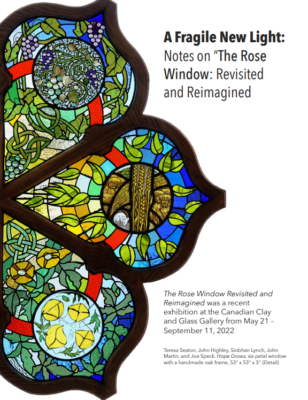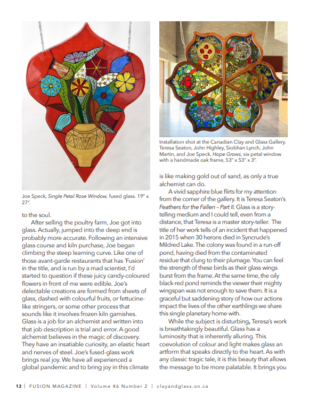Our Artistic Group of Glass (AGOG) had an article in the Fusion Clay and Glass Magazine titled: A Fragile New Light, Notes on “The Rose Window: Revisited and Reimagined” about our summer show at the Canadian Clay & Glass Gallery.
Thanks to Bethany Scott at FUSION: The Ontario Clay & Glass Association for the wonderful article.
MAGAZINE | FUSION I The Ontario Clay and Glass Association

I felt confident enough in my Art History that I could write a short article on the exhibition, Rose Window without ‘Davinci Coding’ my way into a conspiracy theory. When thinking about it, I started envisioning spiraling turrets, incensed air, carved wooden tables, golden chalices and velvet upholstery. A space, minus the crucifixes, that may have been curated by Dracula.
Upon entering the Canadian Clay and Glass Gallery, I quickly realized my mistake on two levels. After a nod to the original rose windows of Gothic architecture, the exhibition quickly slipstreamed into the present. Hence the ‘Reimagined’ part, I somehow overlooked. Secondly, my Art History textbook seemed to have shoved a bookmark in at the medieval period and then closed the book on glass. Although glass has never received the credit it deserves, it is an artform with a 3600-year-old history. The human/glass relationship is a living one. The longer I stayed and listened the more I would understand.
The rose windows we think of in cathedrals were used to communicate religious messages, depict biblical imagery and beautify the sanctuary, giving the congregation a little sample of the divine. A paradise. Possibly one with seating more comfortable than a pew bench.
But the pieces in this exhibition were free from the sturdy mason edifices of the past. Instead, they hung weightlessly from overhead timber beams, brightening the breezy gallery space, like a floating glass garden. Such was the case with the large six petaled piece, Hope Grows which was a collaboration done by Teresa Seaton, Joe Speck, John Highley and Siobhan Lynch.
Here was a world brimming with life. Layers of lilacs and leaves, roots and knots, poppies, grapes and harvest mice spill forth. It is a celebration of nature and the passage of time. Like the seasons, glass is the art of continuity, but one that is in constant flux. Liquid and molten. Fragile but durable. A window that is inside and outside. Hovering in a state of neither and both. Glass is the permanent in-between. Hope Grows is this frozen moment of transformation.
There are those of us that buy the adult colouring book with the overpriced pencil crayons, use them for 14 seconds, then shove the whole experience under the coffee table. Then there is John Highley. Looking at his bold and vibrant glass mosaic, Strasbourg Cathedral is like looking at a peacock feather through a kaleidoscope. John has been crafting in glass for 28 years. The mosaic technique allows his creations to be extremely detailed and intricate. Each tiny fragment of glass is placed like a memory until the work, like a well-lived life, can be fully appreciated looking back.
Taking 80 hours to complete, Highley’s work is a chromatic journey which is as much an artform as the completed piece. A master-class in patience, John trusts that every piece will eventually come together in the end. His is the craft of being present. The art of thinking on your feet, problem solving, learning, improving, evolving, failing and succeeding and failing again. If there are times you can’t think your way through the puzzle, you must feel your way.
It was this ‘feeling’ that caught me off guard when I encountered Joe Speck’s piece titled, Single Petal. Here is a single red petal of a rose. A singled-out panel of the rose window. On its surface is a cheerful bouquet uninterrupted by copper foil. The fused glass technique that Joe employs gives the appearance of being rather solid. Two wires, thinner than a shoelace on a brogue, hold this 20-pound piece of glass. My first feeling was how unfortunate it is that I will never trust anyone or anything as much as Joe Speck trusts his nichrome wire. My second feeling was that this piece genuinely brings joy to the soul.

After selling the poultry farm, Joe got into glass. Actually, jumped into the deep end is probably more accurate. Following an intensive glass course and kiln purchase, Joe began climbing the steep learning curve. Like one of those avant-garde restaurants that has ‘Fusion’ in the title, and is run by a mad scientist, I’d started to question if these juicy candy-coloured flowers in front of me were edible. Joe’s delectable creations are formed from sheets of glass, dashed with colourful fruits, or fettucine [1] like stringers, or some other process that sounds like it involves frozen kiln garnishes. Glass is a job for an alchemist and written into that job description is trial and error. A good alchemist believes in the magic of discovery. They have an insatiable curiosity, an elastic heart and nerves of steel. Joe’s fused-glass work brings real joy. We have all experienced a global pandemic and to bring joy in this climate is like making gold out of sand, as only a true alchemist can do.
A vivid sapphire blue flirts for my attention from the corner of the gallery. It is Teresa Seaton’s Feathers for the Fallen – Part II. Glass is a story[1]telling medium and I could tell, even from a distance, that Teresa is a master story-teller. The title of her work tells of an incident that happened in 2015 when 30 herons died in Syncrude’s Mildred Lake. The colony was found in a run-off pond, having died from the contaminated residue that clung to their plumage. You can feel the strength of these birds as their glass wings burst from the frame. At the same time, the oily black-red pond reminds the viewer their mighty wingspan was not enough to save them. It is a graceful but saddening story of how our actions impact the lives of the other earthlings we share this single planetary home with.
While the subject is disturbing, Teresa’s work is breathtakingly beautiful. Glass has a luminosity that is inherently alluring. This coevolution of colour and light makes glass an artform that speaks directly to the heart. As with any classic tragic tale, it is this beauty that allows the message to be more palatable. It brings you close so the story can unfold, even though, in the end, it reveals in inconvenient truth.

Communicating through glass requires experience, a trust in the material and a great deal of intuition. Teresa knows the effect of a carefully planned pause. As with a story told around a campfire, she crafts with intention, then sits back and allows the light to work its magic.
Glass can be an unforgiving material. The wrong cut. The wrong pressure. To work with glass is as much a science as it is an art. Siobhan Lynch has been working with glass for 20 years. She was a reluctant convert eventually embracing the medium and finding a freedom in endlessly exploring how the complexity of glass could be interwoven into her own intricate knotwork designs.
Many of her patterns have survived from times long past. Times that held no distinction between astronomy and astrology. The rhythms of the year and passages of time still held something of mystery. Siobhan’s piece, Almanac, depicts the lunar calendar as described by The Witches Book of Days where thirteen different trees represent the thirteen different lunar cycles. The piece is modeled after the South Rose Window of the Lausanne Cathedral, a window known as the calendar in glass and stone.
The flowing lines and movement of the Celtic Imagery are reminiscent of illuminated manuscripts. As light filters through, Siobhan’s work is truly illuminated. As the sun moves along its arc in the sky, light dances across her piece in a way that makes me certain that I could stand in front of it every day and never see the same piece twice.
The ‘Rose Window’ was transformative, absolutely. Not in the way I’d thought. I suspected there would be religious imagery, a ‘Garden of Eden’. Amongst the knotted brambles and rugged escarpments, glimmering fish and vibrant pansies, I found a glass garden of the here and now. I could sense fragility and a boldness. I could recognize the challenges and heartbreaks, the curiosity, the sense of wonder and discovery, the joy, the mourning, and the endless relentless change. The Rose Window was not a glimpse into an imagined divine future, but rather a story. One that felt familiar- and one that felt very human.
Bethany Scott is a functional potter based in Orillia, Ontario. Her first introduction to clay was through her Grandfather, a potter who immigrated to Canada from the Netherlands. A love of the craft led her to pursue a Degree in Art History from McGill University followed by a Degree in Fine Art from Emily Carr University. When away from the wheel she explores her passion for Ceramic History. @rockpaperpoison
